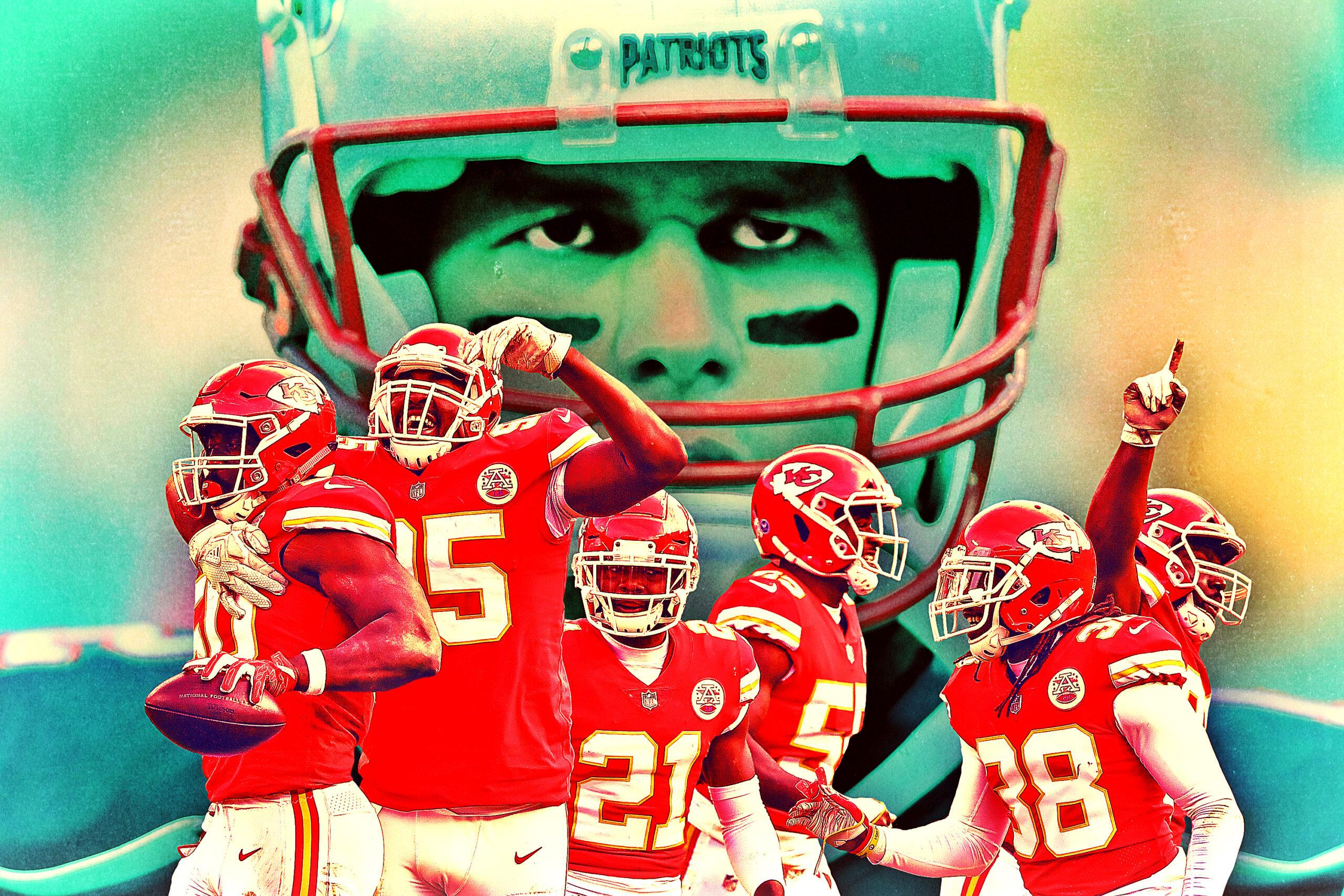
The defining story of the Chiefs’ extraordinary season certainly hasn’t been its defense. Kansas City finished the regular season 12-4 and secured the AFC’s no. 1 seed on the back of its jaw-dropping Patrick Mahomes II–led offense, dominating in spite of a defensive unit that finished second to last in yards allowed (405.5 per game) and surrendered 26.3 points per contest (24th). But while the regular-season numbers certainly don’t inspire much confidence, the Chiefs’ much-maligned defense played a crucial role in last week’s divisional-round win over the Colts, and it looks to be playing its best football at the right time.
That unit is led by its dominant, smothering front line trio of Justin Houston, Chris Jones, and Dee Ford. And, boosted by what’s sure to be a deafening Arrowhead crowd, the Chiefs’ defense has a chance to shed its regular-season reputation and play a crucial role in taking down Tom Brady and the Patriots.
You wouldn’t be alone if Kansas City’s defensive performance last week against Indianapolis caught you off guard. The Chiefs defense dominated from the jump—they forced Andrew Luck and the Colts offense to three-and-outs on each of Indy’s first four drives—and held the Colts out of the end zone until deep into the fourth quarter (the team’s only points in the first three frames came on a blocked punt). The performance was emblematic of how an elite pass-rushing front can take over a game, particularly against a team that’s playing from behind; K.C.’s pass-rushing triumvirate of Jones, Houston, and Ford got near-constant pressure up front, registering a combined three sacks, five quarterback hits, and four pass breakups. The formula was simple: get the edge, collapse the pocket, make Luck uncomfortable, and create havoc.
Every time it looked like the Colts were threatening to score, the Chiefs defensive line would pin its ears back and make a play. With Kansas City holding a 24-7 lead late in the third quarter, Indy had pushed into Chiefs territory and faced a third-and-6 from the K.C. 45-yard line. Houston, lined up next to Ford on the defensive left, knifed through the line and brought Luck down for a huge loss, forcing a Colts punt.
Indy got the ball right back, though, when Chiefs receiver Sammy Watkins fumbled on next drive, setting the Colts up at the Kansas City 20-yard line with another chance to chip away at the lead. But Ford came through again, this time to create a big takeaway and thwart that thought. Rushing off the left, he exploded around the right tackle and batted the ball out of Luck’s hand. Houston recovered.
Ford nearly forced a second fumble early in the fourth quarter when he hit Luck’s arm as the Colts’ quarterback went to throw. It was ruled incomplete.
The Chiefs’ formidable defensive front made the most of even their “failed” pass-rush attempts. On a number of snaps, Jones got held up by Indy’s talented offensive line, but, undaunted, kept his head on a swivel and jumped up to disrupt the passing lane. He knocked down three passes himself.
The Chiefs’ defense didn’t get much praise throughout the year, but Saturday’s game was certainly not the first time that pass-rush group had shown up and balled out. On the season, Kansas City tied for eighth in ESPN’s pass-rush win rate (55 percent)—second among the remaining playoff teams—and finished tied for 13th in pressure rate per Football Outsiders’ play charting (30.9 percent).
Jones was the NFL’s best interior pass rusher not named Aaron Donald, finishing second among interior linemen in ESPN’s pass-rush win rate (35 percent) while racking up 15.5 sacks (third among all players), 74 pressures (tied for fourth, per Pro Football Focus), 29 quarterback hits (tied for fifth), and 19 tackles for a loss (fifth). Ford had a career year, finishing fifth among edge rushers in pass-rush win rate (31 percent) while notching 13.0 sacks (tied for seventh), 77 pressures (third), 29 quarterback hits (tied for fifth), 13 tackles for a loss (tied for 15th), and seven forced fumbles, tied for the league-high.
Houston, who missed four games in the middle of the season with a hamstring injury, added 9.0 sacks, 32 hurries, and five forced fumbles of his own. His return to the lineup in Week 10 was a catalyst for the Chiefs’ defensive improvement over the second half, and a group that ranked 27th in defensive DVOA after nine weeks heads into the championship round ranked 17th in that metric. The pressure Houston, Ford, and Jones provide has been the spark the team needed to start creating turnovers and limiting opponents’ passing attacks. From Week 10 to the end of the regular season, the Chiefs racked up 26 sacks (tied for 2nd), 14 takeaways (tied for fifth), and 15 forced fumbles (third). This isn’t the defense that New England faced back in Week 6, when Brady and Co. dropped 43 points on Kansas City in a barn-burning win.
It helps immensely that this Chiefs unit is playing at home this weekend. With crowd noise making it difficult for offensive linemen to hear the snap count and communicate, Kansas City’s pass-rushing group has a distinct advantage. In fact, no team registered more quarterback pressures at home this season than the Chiefs (118). In its nine games at Arrowhead this year, Kansas City has surrendered just 17.4 points per game—a stark contrast to their 34.6 point average on the road—and this franchise holds the longest active streak of games without allowing 30-plus points at home (34).
Put it all together, and there is a lot more to this game than the two high-flying offenses (especially considering a massive cold front is moving in on Kansas City). Brady and Co. are going to have to be ready for an improved Chiefs defense in this game, and the first thing they’ll do to mitigate their opponents’ pass rush is to try to run the hell out of the ball. For all of Kansas City’s pass-rush talent up front, they couldn’t defend the run to save their lives. Kansas City finished dead last in run defense DVOA this year, surrendering 132 yards per game and 5.0 yards per carry. That’s a major mismatch in favor of the Patriots, who, fresh off a dominant 155-yard, four-touchdown performance on the ground against the Chargers, will undoubtedly look to impose their will and control the clock. But a purely run-focused tack might not be enough for the Patriots in this game, particularly if the Chiefs offense gets rolling early on.
It’s anyone’s guess as to what New England’s passing game strategy will be; head coach Bill Belichick is a chess master who always seems to be a few steps ahead of his opponents, and there’s no team in the league more schematically flexible. But it wouldn’t be surprising if the Pats try something along the lines of what they did to the Chargers last week, leaning on a heavy load of quick passes that got the ball out of Brady’s hands before he could get hit (his time to throw clocked in at just 2.33 seconds per dropback against L.A and he averaged 4.3 air yards per target, both lowest among the eight starting passers last week). That tactic all but neutralized Joey Bosa, Melvin Ingram, and L.A.’s top-tier pass-rushing group, which recorded zero sacks and hit Brady just twice on 44 dropbacks.
The Chargers made things too easy on the Patriots last week, though, playing primarily Cover-3 zone looks that gave Brady all the coverage cushion he needed to get the ball out in a hurry. The Chiefs, who played more man coverage than all but five teams this year, will look to stick close to receivers, deny quick passing options, and disrupt the timing of the Patriots’ passing attack. Taking away Brady’s first read could provide enough time for Houston, Ford, and Jones to do damage. That’s the theory, anyway: Brady’s made a career of being immune to pressure, and he led the NFL in passer rating under pressure in 2017 (96.6), per PFF. But this year his passer rating was just 71.2 in those situations—21st among qualifying quarterbacks. If the Chiefs can generate pressure, the 41-year-old Brady may be more vulnerable than ever.
There’s too many scintillating matchups in this game to count, but the one I’ll be watching most closely is that of the Chiefs’ defensive front and the Patriots’ talented offensive line. If New England can keep Brady clean, it’s not hard to imagine him picking the Chiefs defense apart. But if that talented group can do what it did last week against the Colts and get the future Hall of Famer off balance and out of sorts, it could be the X factor Kansas City needs to punch its ticket to Atlanta for Super Bowl LIII.

